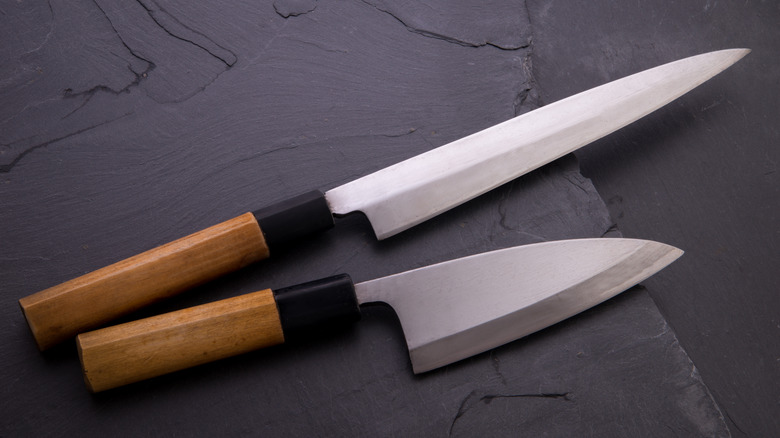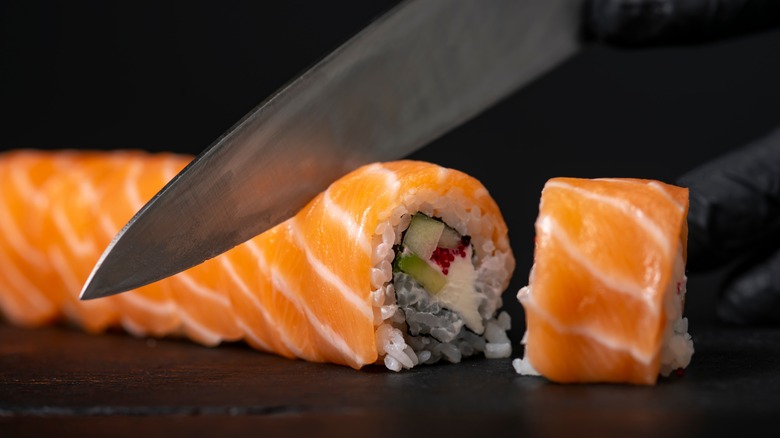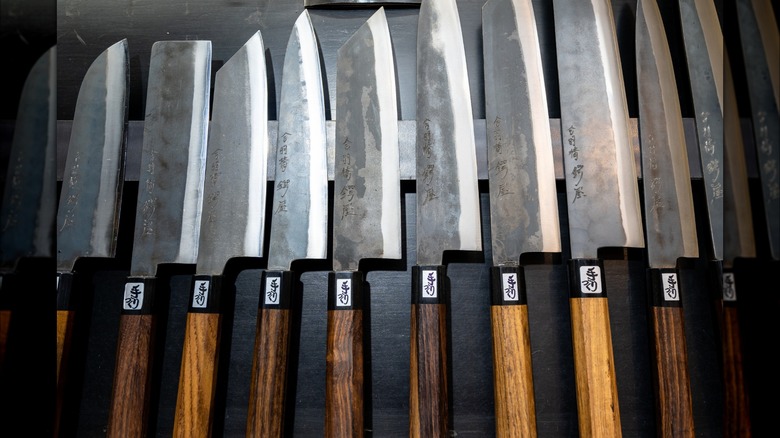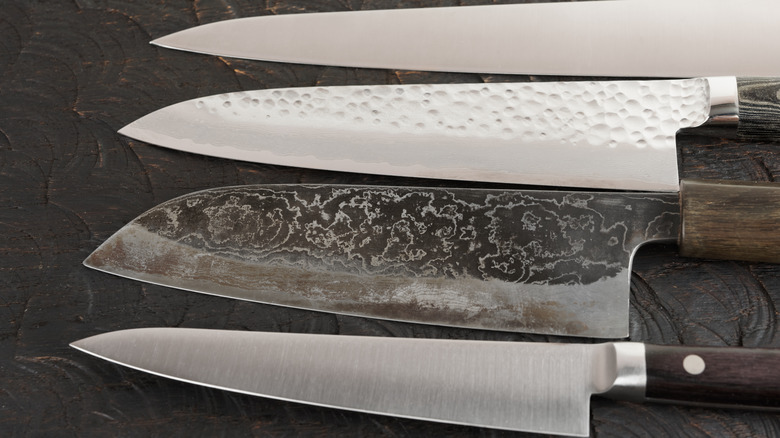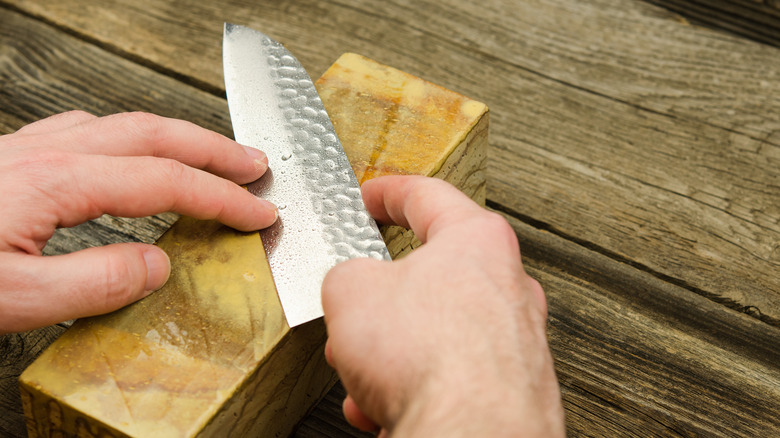What Makes Japanese-Style Chef's Knives So Unique
A chef's knife is the workhorse and star of the kitchen for every professional chef or home cook. If you're considering an upgrade from the department store set you got on sale ages ago, many brands of chef's knives that are made in Japan are probably coming up in your research. But what makes Japanese-style chef's knives special?
When compared to Western-style — the other main category of chef's knives — Japanese style differs in the hardness and metal composition, angle of the blade, and type of handle. The blade tends to be harder, and they usually are made with the cutting edge on only one side. The handle is typically one piece — while Western handles are made with two conjoined pieces (though this is a relatively recent development). That is because Japanese chef's knives are modeled after Western chef's knives. When Japan began trading with Western countries in the 1800s, beef joined local diets — a significant change for a cuisine largely based on vegetables and delicate fish. The Japanese now needed heftier knives for cutting up the tougher protein.
There was already an ancient tradition of blade craftsmanship, but chef's knives are a newer development. Interestingly, when the Japanese government banned the public carrying personal weapons in the late 1800s, sword makers shifted to making kitchen knives as a way to make up for lost business, bringing their artistry to the task — this cultural history of bladesmithing has greatly influenced the aesthetics of modern, Japanese-style chef's knives.
The blade
Japanese chef's knives have a blade made out of carbon steel. Steel is a combination of several elements including iron, carbon, and others, and carbon steel has an even higher carbon content. This makes the steel itself harder, so it can be made sharper and finer. The trade-off is that it is more brittle. The softer but more durable steel used in Western-style knives is less likely to chip but doesn't have as much finesse. The Rockwell scale is used to rate hardness, and Japanese knives fall between 58 and 65 while Western knives range from 52 to 56.
The design of the blade is also unique. Japanese blades tend to be flatter, which is ideal for the push or pull cut that is common in Japanese cooking styles. "You cut with a diagonal movement from back-top to bottom-front. After each cut, you lift the blade and return it to the starting position," explains Knives and Tools. Western-style knives tend to have more of a curve, which lends itself to a rocking cut.
Most traditionally, Japanese blades have a single bevel, which means that only one side of the blade has a cutting edge while the other side slopes straight down. Western-style blades are double-beveled, so both sides of the blade slope equally into a cutting edge. Many Japanese blades are now made with a 70/30 double bevel meaning that both sides of the blade are angled, but one side much less so than the other.
The handle
The Japanese refer to a traditional handle as a "wa" handle and Western-style as a "yo" handle. Customarily, Japanese-style chef's knives have a wooden handle that encases a full tang. The tang is the long, comparatively thin part of the blade that provides balance and stability to the sharpened blade. Often, Japanese knives use a tapered, partial tang, so it is completely covered by the handle. Because of this, rivets are not needed to secure the tang in place as is common in Western knives. Though Western-style knives can also be made with a partial tang, they often utilize a full tang that is sometimes left visible at either the front of the handle closest to the heel of the blade — the bolster — or at the back of the handle, aka the butt.
Partial tang knives have less steel and need fewer materials to hold the whole knife together, so Japanese-style chef's knives tend to be lighter than their Western counterparts. They also lend themselves to a partial or pinch grip, which is where the cook holds the knife by pinching the top of the base of the blade with their fingers, keeping their palm around the handle.
Popular styles of Japanese chef's knives
A chef's knife is a multi-purpose tool, and the size and style you prefer largely depend on the shape of your hand and your style of cutting. The gyuto knife is the most versatile and most comparable to a Western-style chef's knife. It has a slim, pointed, slightly rounded blade that lends itself to both push or pull and rocking styles. It has enough heft for big pieces of meat, but it is still delicate enough to handle tasks like filleting a fish.
A santoku knife is another popular go-to with a shorter blade and distinct shape, and it also happens to be Giada De Laurentiis' favorite knife. It does not gradually taper, but instead, slopes to a point only at the very tip. The uniform shape makes this knife perfect for push or pull cutting, and it is specifically designed to work well for multiple uses.
Kiritsuke knives also have relatively flat blades with points and are typically used to finely slice fish. Nakiri knives have a rectangular blade with a flat bottom and are ideal for cutting vegetables.
Why you should consider a Japanese-style chef's knife
Truly, there is no better or worse style of knife, and finding the right chef's knife totally comes down to your preferences, technique, and desired use. Part of the decision is based on philosophy. Japanese knives are built around the idea of damaging the food as little as possible, so lightweight tools are prized for their ability to handle ingredients delicately. On the other hand, Western knives are heavier to let gravity do its thing, so the cook can apply as little pressure as possible.
A Japanese-style knife is for you if you prioritize precision, delicate knife work, a light touch, and a push-or-pull cutting style. A Western-style knife may be a better choice if you prefer a rocking cut and a heavier touch. How the different weights of these knives feel in your hand is also important to consider.
Additionally, Japanese-style knives do require more upkeep. When sharp, they will hold that edge for quite some time due to the higher concentration of carbon, but because the blade is more brittle, it is very normal for them to chip with regular use. This can be fixed with routine maintenance on a whetstone to smooth the blade, but that requires a time investment in both doing the task itself and learning how to do it well.

